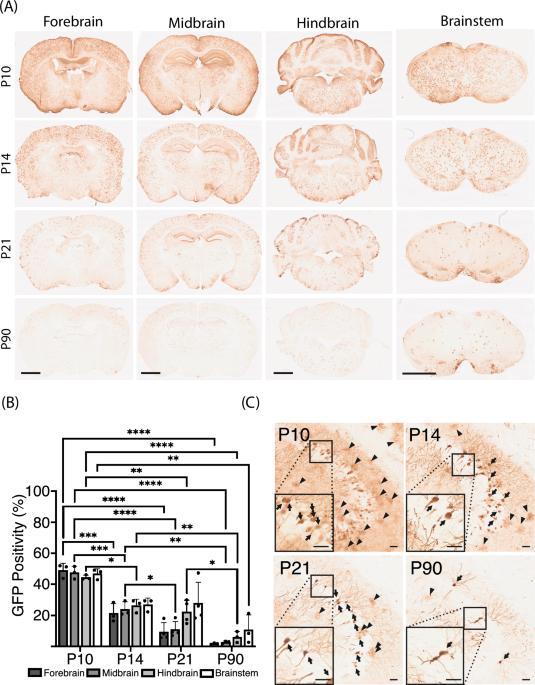Expression and distribution of rAAV9 intrathecally administered in juvenile to adolescent mice
IF 4.5
3区 医学
Q1 BIOCHEMISTRY & MOLECULAR BIOLOGY
引用次数: 0
Abstract
Intrathecal (IT) lumbar puncture delivery of recombinant adeno-associated virus serotype 9 (rAAV9) is a gene therapy approach being explored in preclinical studies and ongoing gene therapy clinical trials for neurological diseases. Few studies address IT rAAV9 vector distribution, tropism, and expression with respect to age of administration. Therefore, we IT delivered a rAAV9/GFP vector in mice at ages ranging from early postnatal development through adulthood (P10-P90). Tissues were assessed for transgene expression, cell tropism, and vector distribution. In the CNS, transduction was highest when delivered at post-natal day 10 (P10) and there was an age-dependent decline in transduction. We found higher transduction of astrocytes relative to neurons when rAAV9 was administered at younger ages and a switch to higher neuronal transduction with delivery at older timepoints. Biodistribution analysis of peripheral tissues showed that when delivered at P10, rAAV9 has the greatest distribution to the heart. Conversely, at P90 rAAV9 liver distribution was highest. As rAAV9 IT-delivered gene therapies continue to emerge for neurological diseases, careful consideration of the age of delivery should be taken in relation to the expected distribution and cell expression in animal models, and how this may translate to human studies.

rAAV9在幼年至青春期小鼠体内的表达和分布。
腰椎穿刺鞘内注射重组腺相关病毒血清型 9(rAAV9)是临床前研究和正在进行的神经系统疾病基因治疗临床试验中探索的一种基因治疗方法。很少有研究涉及 IT rAAV9 载体的分布、滋养和表达与给药年龄的关系。因此,我们在小鼠从出生后早期发育到成年期(P10-P90)的不同年龄段对rAAV9/GFP载体进行了IT给药。我们对小鼠组织的转基因表达、细胞滋养和载体分布进行了评估。在中枢神经系统中,出生后第 10 天(P10)转导率最高,转导率随年龄的增长而下降。我们发现,相对于神经元,rAAV9 在较小的年龄段给药时,星形胶质细胞的转导率较高,而在较大的时间点给药时,神经元的转导率转为较高。外周组织的生物分布分析表明,在 P10 给药时,rAAV9 在心脏的分布最广。相反,在 P90 时,rAAV9 在肝脏的分布最多。随着治疗神经系统疾病的 rAAV9 IT 给药基因疗法不断涌现,应仔细考虑给药年龄与动物模型的预期分布和细胞表达的关系,以及如何将其转化为人体研究。
本文章由计算机程序翻译,如有差异,请以英文原文为准。
求助全文
约1分钟内获得全文
求助全文
来源期刊

Gene Therapy
医学-生化与分子生物学
CiteScore
9.70
自引率
2.00%
发文量
67
审稿时长
4-8 weeks
期刊介绍:
Gene Therapy covers both the research and clinical applications of novel therapeutic techniques based on a genetic component. Over the last few decades, significant advances in technologies ranging from identifying novel genetic targets that cause disease through to clinical studies, which show therapeutic benefit, have elevated this multidisciplinary field to the forefront of modern medicine.
 求助内容:
求助内容: 应助结果提醒方式:
应助结果提醒方式:


